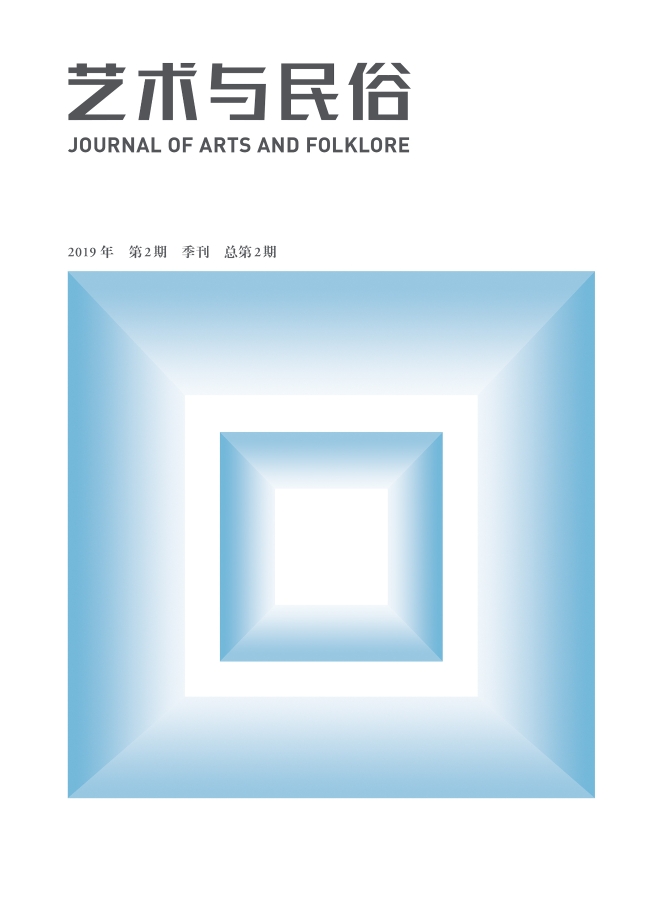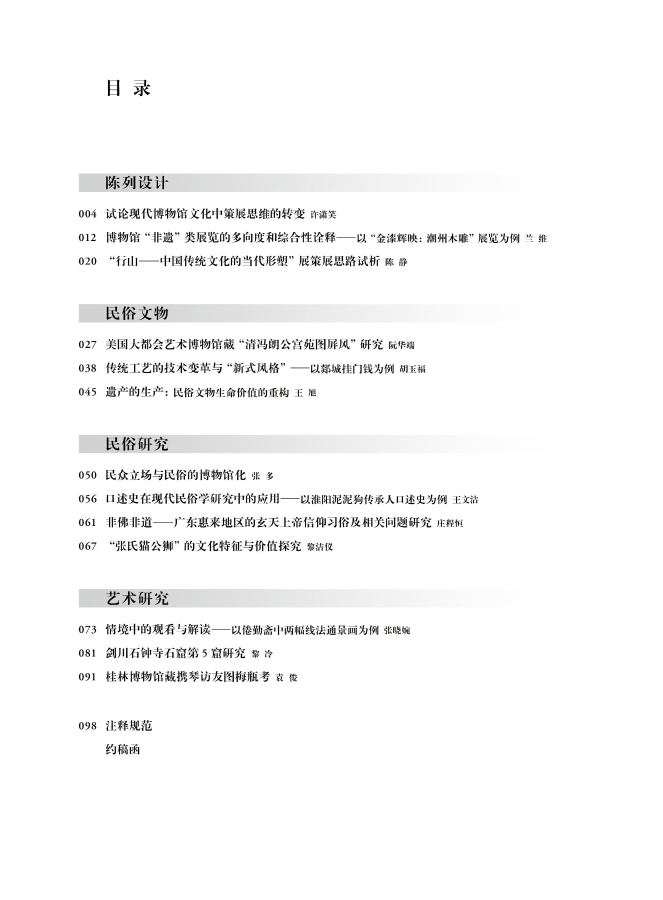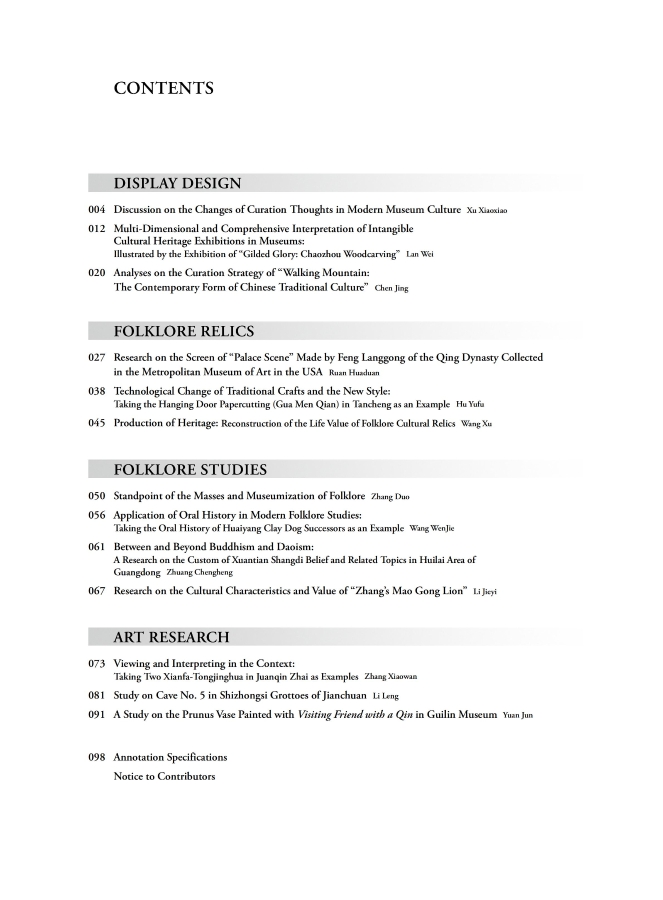


摘要部分:
1、试论现代博物馆文化中策展思维的转变
Discussion on the Changes of Curation Thoughts in Modern Museum Culture
许潇笑
摘要:随着新博物馆学理论的传播与实践,变化的社会语境成为现代博物馆文化构建与发展的重要依据。在视觉文化高度发展的当下,展览及其背后运作日渐成为专门的学科体系,成为博物馆社会身份认知与特定价值实现的有效载体。该文从现代博物馆所面临的社会语境切入,通过策展要素剖析策展思维转变的依据与方法,结合杭州工艺美术博物馆的策展实践,尝试分析和论述如何在现代博物馆文化中通过思维的转换、实践的摸索,以展览为支点,知识生产与公共性构建为杠杆,构建博物馆与当下文化形态之间的对话路径。
关键词:博物馆 策展 现代性
Abstract: As new museology concepts are being transmitted and practiced, the changing social context has become an important basis for the construction and development of modern museum culture. Particularly considering the booming visual culture at present, exhibitions and
the increasingly specialized discipline system behind them are essential and effective to demonstrate the social identity and particular values of museum. The paper begins with the social contexts around modern museum, and analyzes different elements in curation to examine the conditions and ways when curation thoughts change. With examples of curation practice in Hangzhou Arts and Crafts Museum, it also discusses how to construct the communication pathway between museum and current cultural contexts in modern museum culture through the change of thought and experimental practices of curation, and using exhibition as the pivot and knowledge production with commonality as leverage interact.
Keywords: Museum, Curation, Modernity
2、博物馆“非遗”类展览的多向度和综合性诠释—以“金漆辉映:潮州木雕”展览为例
Multi-Dimensional and Comprehensive Interpretation of Intangible Cultural Heritage Exhibitions in Museums: Illustrated by the Exhibition of “Gilded Glory:Chaozhou Woodcarving”
兰 维
摘要:博物馆参与非物质文化遗产保护和展示积累了丰富的经验,学术界也多有探讨。潮州木雕是我国著名的传统雕刻艺术,主要流行于广东潮汕地区。作为传统美术类“非遗”,潮州木雕近年来在博物馆中也得到了越来越多的展示。“金漆辉映:潮州木雕”展作为粤港合作的大型“非遗”类展览,对潮州木雕进行多向度、综合性的诠释,展览得到了各界观众的好评。结合学界对博物馆“非遗”展览的研究,该文对此展的多向度和综合性特点进行了详尽阐述和分析,在此基础上对传统美术类“非遗”在博物馆的未来展示问题进行了相应探讨。
关键词:博物馆 “非遗” 展览 潮州木雕
Abstract: Museum has accumulated rich experience in conserving and exhibiting intangible cultural heritage, and this has been discussed much in academia. Chaozhou woodcarving is a famous traditional carving art in China, and mainly popular in the Chaoshan region of Guangdong.As an intangible cultural heritage of traditional fine art, Chaozhou woodcarving has been exhibited more and more in museums in recent years.“Gilded Glory: Chaozhou Woodcarving", a large-scale exhibition on intangible cultural heritage co-organized by institutions of Guangdong and Hong Kong, was well received by audiences from all social walks with its multi-dimensional and comprehensive interpretation on Chaozhou woodcarving. Combining with the studies in academia on intangible cultural heritage exhibitions in museums, the paper elaborates and analyzes the above mentioned two features of this exhibition. It also discusses the problems faced by museum exhibitions on intangible cultural heritage of traditional fine art in the future.
Keywords: Museum, Intangible Cultural Heritage, Exhibition, Chaozhou Woodcarving
3、“行山—中国传统文化的当代形塑”展策展思路试析
Analyses on the Curation Strategy of “Walking Mountain: The Contemporary Form of Chinese Traditional Culture”
陈 静
摘要:2018 年,河北博物院举办了“行山—中国传统文化的当代形塑”展,共展出国内知名雕塑家创作的雕塑作品45 组。展览思考了如何用当代艺术连接传统与未来,探索了在博物馆举办当代艺术类展览的策展思路、推广模式,一系列创新实践为博物馆艺术类展览的策划及实施提供了借鉴。
关键词:博物馆 策展 现代性
Abstract: In 2018, Hebei Museum held the exhibition of “Walking Mountain: The Contemporary Form of Chinese Traditional Culture” which displayed 45 groups of sculptures created by famous domestic sculptors. The exhibition considered how to connect the tradition and the future with contemporary art, and explored the curation strategies and promotion models which museums may utilized to hold contemporary art exhibition. A series of innovative practices provide a reference for the planning and implementation of the art exhibition.
Keywords: Museum, Curation, Modernity
4、美国大都会艺术博物馆藏“清冯朗公宫苑图屏风”研究
Research on the Screen of “Palace Scene” Made by Feng Langgong of the Qing Dynasty Collected in the Metropolitan Museum of Art in the USA
阮华端
摘要:款彩是晚明清初时期极具特色的漆器艺术品类,该文以美国大都会艺术博物馆所藏“清冯朗公宫苑图屏风”为研究对象,从该屏风的贺寿序文及落款入手,结合正史、方志等文献材料,对屏风的递藏经过、制作背景、人物事迹、产地与作坊等进行分析研究,以揭示其重要价值。
关键词:款彩 寿屏 李彬 白元贞 冯朗公
Abstract: Coromandel lacquer (Kuan Cai) is a type of lacquer artwork with unique characteristics in the late Ming and early Qing dynasties. This paper takes the Screen of “Palace Scene” made by Feng Langgong of the Qing Dynasty, collected in the Metropolitan Museum of Art in the USA,
as the research object, starting with the preface of birthday greetings and inscription of the screen, combining literature materials including the official history records and local chronicles, analyzes and researches the screen’s transmitting and collecting history, crafting background, related characters and their deeds, origin and making workshop, etc. to reveal its significance.
Keywords: Coromandel Lacquer (Kuan Cai), Screen for Birthday Celebration, Li Bin, Bai Yuanzhen, Feng Langgong
5、传统工艺的技术变革与“新式风格”—以郯城挂门钱为例
Technological Change of Traditional Crafts and the New Style:Taking the Hanging Door Papercutting (Gua Men Qian) in Tancheng as an Example
胡玉福
摘要:在现代社会,技术变革对于传统工艺的冲击已经不可避免。从手工制作到机器生产的这一转变过程中,往往会引起很多质疑,呈现出一种非此即彼的二元对立状态。深入到山东省临沂市郯城县挂门钱生产消费的实际状态及社会背景的变迁过程之中我们发现,手工挂门钱和机器挂门钱在相互竞争中呈现一种相得益彰的状态,手工挂门钱作为传统文化得到保护,机器挂门钱发展出符合现代消费理念的“新式风格”。事实上,我们需要超越“二元对立”的悲观态度,从造物的身体技术、技艺传承的动力、生产与消费的互动等多重角度来理解,而非单一地从“机器与手工对立”的观点来看待技术变革这个复杂的过程。
关键词:挂门钱 技术变革 消费 新式风格
Abstract: In modern society, the impact of technological change on traditional crafts has been inevitable. The transition from handcrafting to machine production often raises many doubts, showing a binary opposition that the two sides are against one another. When exploring the actual state of the production and consumption of hanging door papercutting (Gua Men Qian) in Tancheng, Linyi, Shandong, we discovered that the handmade papercutting and the machine made one show reciprocally reinforced in competition, while the handmade is protected as a traditional cultural craft, the machine made is developing a new style that matches the concept of modern consumption. In fact, we need to transcend the pessimistic attitude of binary opposition and understand it from multiple perspectives, such as physical technique in creation, the power of craftsmanship inheritance, and the interaction between production and consumption, rather than looking at the complex process of technological change solely from the perspective of opposition between the machine made and the handmade.
Keywords: Hanging Door Papercutting (Gua Men Qian), Technological Change, Consumption, New Style
6、遗产的生产:民俗文物生命价值的重构
Production of Heritage: Reconstruction of the Life Value of Folklore Cultural Relics
王 旭
摘要:民俗文物一般被定义为反映民间风俗、习惯等民俗现象的遗迹和遗物,与历史文物相比一直处于不被重视的边缘地位,理论和实践研究相对滞后。该文通过对这一问题的学理反思,指出民俗文物是一种生活文化遗产,传统上以“物”为中心的静态展示方式无法体现其真正的价值意义。博物馆应当以游客体验为中心,在遗产的生产和发现过程中,重构人与物之间的情感关系,为遗产创造新的价值,焕发遗产的“第二次生命”。
关键词:民俗文物 遗产生产 价值重构
Abstract: Folklore cultural relics are generally defined as cultural heritage which reflects the folk customs. In comparison with historical relics, they are always in a marginal status and are not much accounted of, and the theory and practice of them are relatively lagging behind. Through the academic reflection on this issue, this paper points out that folklore cultural relics are a kind of life cultural heritages. The traditional static display method, which makes the physical “object” centered, cannot reveal the true value of folklore cultural relics. Museum should focus on visitors’
experience to reconstruct the emotional relationship between people and the objects in the process of production and invention of the heritage,create new value for the heritage, and revive the “second life ”of the heritage.
Keywords: Folklore Cultural Relics, Production of Heritage, Value Reconstruction
7、民众立场与民俗的博物馆化
Standpoint of the Masses and Museumization of Folklore
张 多
摘要:随着21 世纪中国社会民俗文化复兴的思潮涌动,越来越多的民俗文化被视为值得珍视的文化遗产,从而被遗产化。在民俗遗产化的实践中,民俗的博物馆化是重要手段。既有的民俗博物馆大多是建立在专家观点基础上的传统文博模式,将民俗的遗产化简单归结为物化的“民俗文物”,在博物馆策展过程中通常没有吸纳社区中民俗持有者的参与。站在民众立场上重新审视民俗文物概念支配下的民俗博物馆,会发现传统文物思维体现的是专家、精英的立场与趣味,这样的理念未必适合民俗博物馆的发展需求。未来的民俗博物馆化实践,应更多地将评判、选择、展示、鉴赏民俗的话语权交还给特定社区、群体及个人,将民众
视为民俗博物馆化实践的主体之一。
关键词:民俗文物 民众立场 遗产化 博物馆化 民俗博物馆
Abstract: With the surging tide of the revival of Chinese folklore culture in the 21st century, more and more folklore objects are regarded as cultural heritage worthy of being cherished and thus being inherited. In the practice of folklore heritagization, the museumization of folklore is an important means. Most of the existing folk museums are established in a traditional model of cultural relics and museology based on expert opinions. The folklore heritagization is simplified to the materialized “folklore cultural relics”. In the course of museum curation, folklore holders in the community usually are not involved. Re-examining the folklore museum under the control of the concept of folklore cultural relics from the standpoint of the masses, we find that this traditional concept reflects the ideas and interests of the experts and elites. Such a concept may not meet the development requirements of folk museums. In the future museumization of folklore, specific communities and groups of individuals should have a voice to judge, select, display, and appreciate folk customs, and the masses of people should be regarded as one of the subjects of the practice of folklore museumization.
Keywords: Folklore Cultural Relics, Standpoint of the Masses, Heritagization, Museumization, Folk Museum
8、口述史在现代民俗学研究中的应用—以淮阳泥泥狗传承人口述史为例
Application of Oral History in Modern Folklore Studies:Taking the Oral History of Huaiyang Clay Dog Successors as an Example
王文洁
摘要:时代发展带来的社会转型使经典民俗学发生了研究范式的转变,即现代民俗学更加关注民俗物象背后的“人”及其日常生活。然而,这种转向后的民俗学如何实践是一个亟须解决的问题,该文拟把口述史这一研究方法运用到现代民俗学的研究当中,借助淮阳泥泥狗传承人口述史的个案,探究口述史对民间艺术品泥泥狗传承保护的现实意义。
关键词:口述史 现代民俗学 “泥泥狗”传承人
Abstract: The social transformation with the development of times has caused a change in the research paradigm of classical folklore, that is to say, modern folklore pays more attention to people and their daily lives behind the folk images. However, how to put into practice the transformed folklore is an urgent problem which needs to be addressed. This paper intends to apply the research method of oral history to modern folklore studies, and explore the practical significance of oral history in the inheritance and conservation of the folk art, Clay Dog, based on the case of the oral history regarding the successors of Huaiyang Clay Dog.
Keywords: Oral History, Modern Folklore, Clay Dog Successors
9、非佛非道—广东惠来地区的玄天上帝信仰习俗及相关问题研究
Between and Beyond Buddhism and Daoism: A Research on the Custom of Xuantian Shangdi Belief and Related Topics in Huilai Area of Guangdong
庄程恒
摘要:玄天上帝本是道教神祇,然而在广东的惠来、陆丰一带却被称为“上帝佛祖”,并以其签诗之灵应,成为该地区普遍存在的民间信仰对象。该文试图从惠来地区的玄天上帝的信仰习俗着手,探究其由“道”入“佛”的相关民间传说和经典来源,同时探讨当前流行的《灵签详解》与《道藏》所录《玄天上帝感应灵签》之间的异同,从而揭示民间信仰习俗是如何将道教经典和民间传说糅合形成其自身的信仰体系—非佛非道的局面。
关键词:玄天上帝信仰 民间信仰 习俗 灵签 道教
Abstract: Xuantian Shangdi (Xuanwu) is a deity in Daoism. However, in Huilai and Lufeng, Guangdong, it is called “God Buddha”. Due to the supposed accurate fortune-telling of its Chim poetry (lottery poems on sticks), it has become a popular folk custom in this area. This paper studies the custom of Xuantian Shangdi belief in Huilai, and hence explores the origin of related folklore and scriptures which reflect how this Daoist belief incorporated into Buddhist teachings. It also discusses the similarities and differences between the current version of Detailed Decoding of Chim Poems and Responded Chim Poems from Xuantian Shangdi in Daozang (Daoist Canon). The study reveals how the folk beliefs and customs establish their own belief system, which is between and beyond Buddhism and Daoism, by combining Daoist scriptures and folklore.
Keywords: Belief of Xuantian Shangdi, Folk Beliefs, Custom, Chim Poem, Daoism
10、“张氏猫公狮”的文化特征与价值探究
Research on the Cultural Characteristics and Value of “Zhang’s Mao Gong Lion”
黎洁仪
摘要:“张氏猫公狮”是粤北韶关地区富有地方乡土气息的一种民间拟兽舞蹈。从根源上看,它是当地人适应山地乡村环境而创造的民俗节庆活动,体现着客家人忠厚重礼、务实创新、灵活求变的精神面貌,其独特的表演过程和道具制作具有丰富的地域文化价值。
关键词:张氏猫公狮 客家精神 套路特色 文化特征
Abstract: “Zhang’s Mao Gong Lion” is a kind of beast-imitated dance which full of local flavor in Shaoguan, the area of northern Guangdong Province. From the source, it is a folk festival created by the local people to adapt to the mountain and rural environment, reflecting the spirit of Hakka people’s loyalty and courtesy, pragmatic innovative and flexibility.Its unique performance process and props production are rich in regional and cultural value.
Keywords: Zhang’s Mao Gong Lion, Hakka Spirit, Routine Characteristics, Cultural Characteristics
11、情境中的观看与解读—以倦勤斋中两幅线法通景画为例
Viewing and Interpreting in the Context: Taking Two Xianfa-Tongjinghua in Juanqin Zhai as Examples
张晓婉
摘要:该文以倦勤斋内两幅线法通景画为研究对象,通过还原观看情境、分析图像与空间关系,试对这两幅图像的意义与作用进行解读。在观看视角下,该文发现部分线法通景画在一定程度上无法自身表意。但置入原空间后,图像和实际空间元素的关系逐渐明朗。通过建立一个完整的空间系统,图像含义寓于环境之中。此过程的完成有赖于观者当下的目光,以及此前和此后的空间记忆。在这种意义上,图像同时被置入了观者的时间序列当中。
关键词:线法通景画 错视画 倦勤斋 观看情境
Abstract: The paper studies two Xianfa-Tongjinghua in the Juanqin Zhai. By restoring the viewing situation and analyzing the relationship between image and space of the painting, the paper attempts to interpret the meaning and role of the panoramic image. From the perspective of viewing, the paper finds out that some of Xianfa-Tongjinghua cannot express their meanings to a certain extent solely by themselves. However, after being placed in the original space, the relationship between the image and the actual space elements becomes clear. By establishing a complete spatial system, the meaning of image lies in the context. The completion of this process depends on the line of sight in the moment and the before and after spatial memory of the viewer. In this sense, the image is simultaneously placed in time series.
Keywords: Xianfa-Tongjinghua, Trompe L’oeil Painting, Juanqin Zhai, Viewing Way
12、剑川石钟寺石窟第5 窟研究
Study on Cave No. 5 in Shizhongsi Grottoes of Jianchuan
黎 冷
摘要:剑川石钟山石窟为南诏到大理国时期开凿的石窟群。由于地处边陲,位置偏僻,交通不便,历来多为学界所忽视,而石窟群中石钟寺第5 号维摩诘经变窟,更是具有极强的特殊性质。从该窟造像各方面综合进行研究,可以明确该窟题材并非之前部分学者提出的是维摩诘经变问疾品,而是根据维摩诘经变中见阿閦佛品第十二里妙喜佛国的题材所凿造。结合多方面的研究可以判断,其开凿时期应为大理国时,系由大理皇室所凿造。两侧的供养人像,身份更是较为罕见的大理国主造像。
关键词:石钟山石窟 石钟寺第5 窟 维摩诘经变 妙喜佛国 大理国皇家石窟 大理国主造像
Abstract: Jianchuan Shizhongshan Grottoes are a group of grottoes built from the Kingdom of Nanzhao to the Kingdom of Dali. Due to the remote location and inconvenient transportation, they have always been neglected by the academia, However, the No. 5 cave of the illustrations of
Vimalakirti Sutra in Shizhongsi area of the grottoes group has particular characteristic. According to the comprehensive studies of the grotto in various aspects, it can be made clear that the grotto does not signify the subject matter in the Consolation of the Invalid-Chapter 5, the illustrations of Vimalakirti Sutra that some scholars put forward before. Nonetheless, it was created to feature the subject matter of the Abhirati in Vision of the Universe Abhirati and the Tathagata Aksobhya-Chapter 12. Combined with various studies, it can be concluded that this grotto was excavated and carved by the Dali royal family during the time of the Dali Kingdom. The identities of the statues on both sides of the grotto were the Dali monarchs, which are less common.
Keywords: Shizhongshan Grottoes, Cave No. 5 in Shizhongsi Area, The illustrations of Vimalakirti Sutra, Abhirati, Royal Grottoes of Dali
Kingdom, Statues of Dali Monarchs
13、桂林博物馆藏携琴访友图梅瓶考
A Study on the Prunus Vase Painted with Visiting Friend with a Qin in Guilin
Museum
袁 俊
摘要:桂林博物馆珍藏着一件明代青花梅瓶,堪称镇馆之宝,其时代被定为宣德年间,主题纹饰被认为是携琴访友图。从该梅瓶整体风格上来说,其所定的时代和主题纹饰名称都值得进一步商榷。该文将从梅瓶的器型、纹饰等方面论证其所属时代,并将瓷器中类似纹样以及携琴访友图样与这件馆藏梅瓶的纹饰进行比较,结合相关绘画题材以及木刻插图图样,分析他们之间的联系,在此基础上,对该梅瓶纹饰主题进行进一步的探讨。
关键词:梅瓶 空白期 携琴访友图 游玩聚会 木刻插图
Abstract: Guilin Museum holds a blue-and-white prunus vase (Meiping) of the Ming dynasty, which can be regarded as a treasure of Guilin Museum. The vase was identified to be made in the Xuande period, and the theme decoration is considered to be the painting Visiting Friend with
a Qin (Chinese Zither). In terms of the overall style of this vase, its identified time and the theme decoration are worthy of further discussion. This paper demonstrates the age of the prunus vase from its utensil type, decoration, etc., further compares the decoration of this vase with the similar patterns of porcelain in the history, studies related painting subjects and the patterns of woodcut illustrations, explores the relationship between them, and determines its decoration theme.
Keywords: Prunus Vase (Meiping), Blank Period, Visiting Friends with a Qin, Outing Party, Illustration of Woodcut